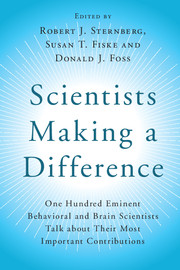 Scientists Making a Difference
Scientists Making a Difference Book contents
- Frontmatter
- Contents
- List of Contributors
- Foreword: Making a Creative Difference = Person × Environment
- Preface
- Part I Introduction
- Part II Biological Bases of Psychology: Genes, Brain, and Beyond
- Part III Cognition: Getting Information from the World and Dealing with It
- Part IV Development: How We Change Over Time
- Part V Motivation and Emotion: How We Feel and What We Do
- Part VI Social and Personality Processes: Who We Are and How We Interact
- Section A Social Cognition
- 74 Doing Good by Doing Good Research
- 75 The Incredible Little Shrinking Man in the Head
- 76 Ethnocentrism and the Optimal Distinctiveness Theory of Social Identity
- 77 Psychology of Gender: Nature and Nurture Working Together
- 78 How Warmth and Competence Inform Your Social Life
- 79 Two Routes to Persuasion
- Section B Personal Relationships
- Section C Group and Cultural Processes
- Part VII Clinical and Health Psychology: Making Lives Better
- Part VIII Conclusion
- Afterword: Doing Psychology 24×7 and Why It Matters
- Index
- References
79 - Two Routes to Persuasion
from Section A - Social Cognition
Published online by Cambridge University Press: 05 August 2016
- Frontmatter
- Contents
- List of Contributors
- Foreword: Making a Creative Difference = Person × Environment
- Preface
- Part I Introduction
- Part II Biological Bases of Psychology: Genes, Brain, and Beyond
- Part III Cognition: Getting Information from the World and Dealing with It
- Part IV Development: How We Change Over Time
- Part V Motivation and Emotion: How We Feel and What We Do
- Part VI Social and Personality Processes: Who We Are and How We Interact
- Section A Social Cognition
- 74 Doing Good by Doing Good Research
- 75 The Incredible Little Shrinking Man in the Head
- 76 Ethnocentrism and the Optimal Distinctiveness Theory of Social Identity
- 77 Psychology of Gender: Nature and Nurture Working Together
- 78 How Warmth and Competence Inform Your Social Life
- 79 Two Routes to Persuasion
- Section B Personal Relationships
- Section C Group and Cultural Processes
- Part VII Clinical and Health Psychology: Making Lives Better
- Part VIII Conclusion
- Afterword: Doing Psychology 24×7 and Why It Matters
- Index
- References
Summary
In the course of our daily lives, we make tons of decisions ranging from the relatively trivial to the more consequential. What should I wear to work? What soap should I buy? For whom should I vote in the Presidential election? The work that my colleagues and I have done over the past several decades has tried to address how people go about evaluating their options and deciding what to do. Our goal has been to build a general model of attitude formation and change that can be applied to virtually any situation in which a person must make a decision or decide on a course of action. As social psychologists, our focus has largely been on how people's own views are influenced by the information provided to them by other people, but we have also studied self-influence.
Although I was very interested in persuasion as a teen – mostly because of the practical benefits of the rare win in arguments with my father – I first became interested in social influence as an academic topic as an undergraduate Political Science major at the University of Virginia. I was intrigued by Richard Neustadt's dictum that the power of the president was merely the power to persuade. Yet, little evidence was available to indicate how voters made their decisions and what factors determined whether citizens were drawn to one side over another. As luck would have it, a social psychologist was offering a small advanced seminar on political psychology that I was allowed to join despite not being a psych major. The course proved so fascinating and relevant to my interests that I vowed to forgo my original law school plans and become a social psychologist instead.
When I arrived in Columbus to enter the social psychology PhD program at Ohio State University, I wasn't entirely sure what to expect. However, as luck would have it once again, I began a friendship and ultimately long-term scientific collaboration with another student entering the program at the same time, John Cacioppo. Ohio State was the perfect place for us to do our individual and collaborative work because of the stellar resources and atmosphere.
- Type
- Chapter
- Information
- Scientists Making a DifferenceOne Hundred Eminent Behavioral and Brain Scientists Talk about Their Most Important Contributions, pp. 373 - 376Publisher: Cambridge University PressPrint publication year: 2016
References
- 1
- Cited by
